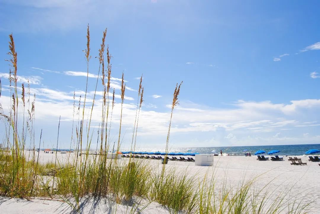Jabberjaw was the only shark we used to see, and he only hurt us with bad jokes.
We swam like fish all over the Gulf of Mexico and never once encountered a shark. As children, then teenagers, and even into adulthood, sharks never bothered us as we swam past the shallow rough area, across the deeper dark blue trough, then further into the emerald green strip of water over the sandbar.We never heard ominous music or observed swerving fins. It never crossed our minds that we could be injured or attacked by anything other than a jellyfish.
We just about fell over laughing when a big, strong, friend from college, who was attending school on a full scholarship for the swim team, refused to go into the Gulf because he was "afraid of sharks."

He grew up in Pennsylvania and explained he never swam anywhere other than the indoor pool. The best swimmer of the bunch sat in the sand while the rest of us frolicked in the salty waves. "Yankee," we sighed.
But now? I'm not so sure I'd feel at ease swimming in the Gulf, or any other body of salt water for that matter. I keep asking myself, what has changed? Why are there suddenly more shark attacks?
Scientists and fishermen have their theories, but as a native Gulf Coast resident, I've also come up with a few of my own ideas, and here's my list of plausible possibilities for the increase in shark encounters.
1. Perhaps sharks are attracted by SPF in our sunscreen. We never used it before and were completely safe. Then again, the opposite may be true; could the strong scent of Hawaiian Tropic coconut oil repel the sharp-toothed beasts? It worked for us.

2. Sometimes, I think the shark population may have grown due to the construction of thousands of condominiums. Before, there was nothing but beautiful sand. And I mean, "nothing." And I mean "beautiful." Now, condos are casting shadows on the water, accompanied by nuclear-hot parking lots that attract white-legged tourists. Could they also be attracting sharks?

3. We may see more sharks now due to the addition of non-native palm trees, which really burns me up. The beaches along Northwest Florida and South Alabama never had Gulf-side palm trees. The smaller "palmetto bushes" or "saw palms" were all we had. Columnist Ted Raymond wrote in the Northwest Daily News, "Palms aren't indigenous to northwest Florida," I'll add for him, "Nor are they native to South Alabama." When Hollywood's idea of Florida palm trees arrived on a landscaper's truck, so did sharks. Coincidence?
4. It seems the static Transistor radios and boom boxes may have deterred the sharks, or maybe it was just the Bee Gees, Air Supply, and Duran Duran.

5. The other noticeable change in shark attacks has been the uncomfortable truth that people are just "juicier" now. The beaches were once filled with skinny folks who snacked on carrot sticks and didn't sit around playing video games and looking at their phones all day. If you've visited the beach lately, you'll observe many who appear to be a shark's dreamy Thanksgiving meal. Speaking of today's beachgoers, has anyone thought that sharks may love the taste of tattoo ink? It's an excellent hypothesis, and you know it.
Be safe out there and take my advice and cover yourself with plenty of AquaNet, Loves Baby Soft, Ralph Lauren Polo, Gee Your Hair Smells Terrific, Bonne Bell Lip smackers (Dr. Pepper flavor worked best), the lingering scent of knit ties, tube socks and Member's Only jackets and anything from Avon.

I'm pretty sure you can also prevent shark encounters by giving yourself a Toni Perm then dousing it with Sun-In for that unnatural greenish-blonde vibe. Sharks will despise you and never come near. Hey, it worked for us.





